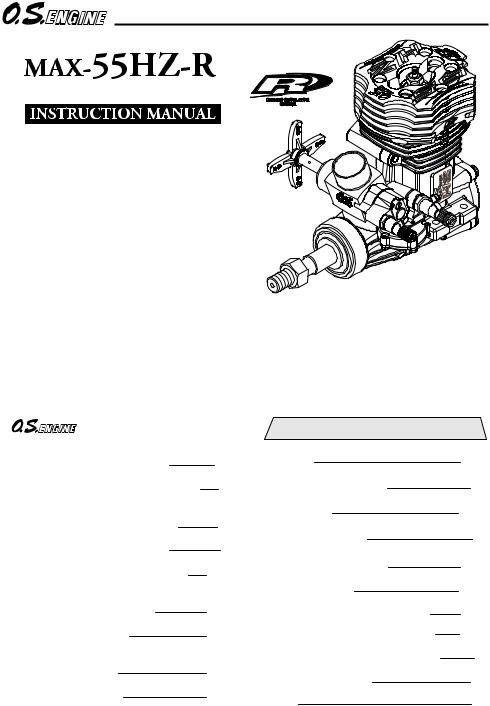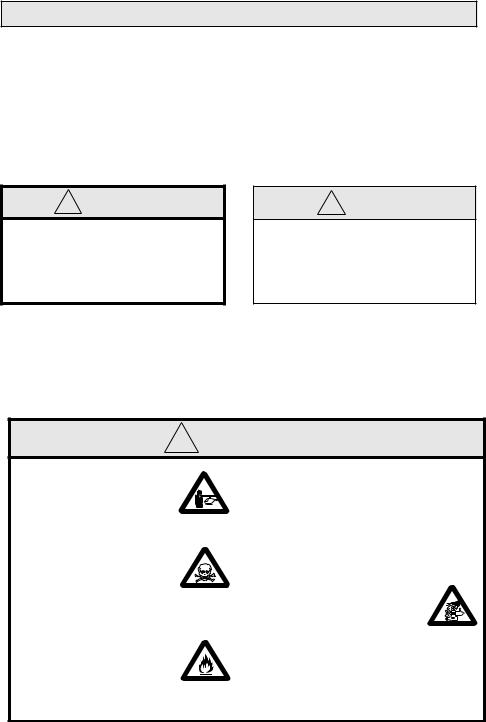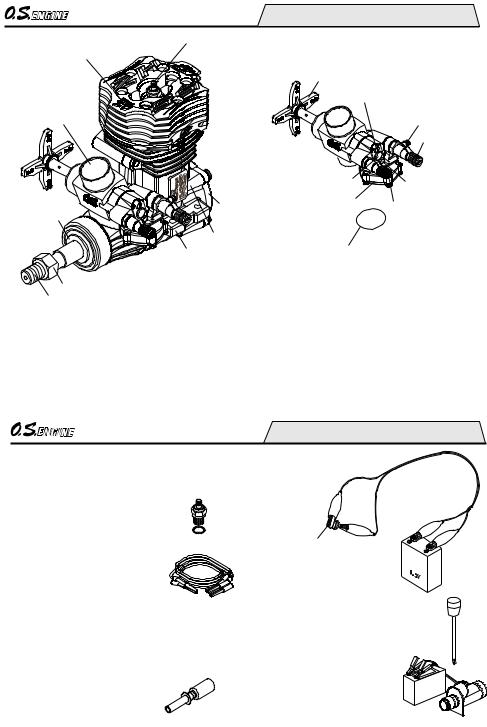O.S. Engines 55HZ-R User Manual

Integrated with O.S. fuel regulator system.
It is of vital importance, before attempting to operate your engine, to read the general 'SAFETY INSTRUCTIONS AND WARNINGS' section on pages 2-5 of this booklet and to strictly adhere to the advice contained therein.
 Also, please study the entire contents of this instruction manual, so as to familiarize yourself with the controls and other features of the engine.
Also, please study the entire contents of this instruction manual, so as to familiarize yourself with the controls and other features of the engine.
 Keep these instructions in a safe place so that you may readily refer to them whenever necessary.
Keep these instructions in a safe place so that you may readily refer to them whenever necessary.
 It is suggested that any instructions supplied with the model, radio control equipment, etc., are accessible for checking at the same time.
It is suggested that any instructions supplied with the model, radio control equipment, etc., are accessible for checking at the same time.
|
|
CONTENTS |
|
|
SAFETY INSTRUCTIONS AND |
|
STARTING |
25-28 |
|
WARNINGS ABOUT YOUR O.S. ENGINE |
2-5 |
|||
|
|
|||
NOTES ON INSTALLING COOLING-FAN ANDCLUTCH |
6-7 |
RUNNING-IN ("Breaking-in") |
29 |
|
NOTES WHEN APPLYING AN ELECTRIC STARTER, |
|
ADJUSTMENT |
30-34 |
|
INSTALLATION OF THROTTLE SERVO |
8-9 |
|
|
|
|
10 |
ADJUSTMENT CHART |
35 |
|
NOTES ON HEATING THE GLOW PLUG |
|
|
||
INTRODUCTION, ENGINE PARTS NAME |
11-12 |
CARE AND MAINTENANCE |
36-37 |
|
|
|
|||
BEFORE STARTING, |
|
TROUBLE SHOOTING |
38-41 |
|
|
|
|
||
INSTALLATION OF THE ENGINE |
13-16 |
ENGINE EXPLODED VIEW & PARTS LIST |
42-43 |
|
GLOWPLUG / CARBURETOR |
17-18 |
CARBURETOR EXPLODED VIEW & PARTS LIST |
44-45 |
|
GLOWPLUGS, ABOUT THE REGURETOR , |
|
O.S. GENUINE PARTS & ACCESSORIES |
46 |
|
ABOUT THE PLUMBING |
19-22 |
THREE VIEW DRAWING |
47 |
|
|
|
|||
CARBURETOR CONTROLS |
23-24 |
MEMO |
48 |
|
|
|
1

SAFETY INSTRUCTIONS AND WARNINGS ABOUTYOUR O.S. ENGINE
Remember that your engine is not a "toy", but a highly efficient internalcombustion machine whose power is capable of harming you, or others, if it is misused.
As owner, you, alone, are responsible for the safe operation of your engine, so act with discretion and care at all times.
If at some future date, your O.S. engine is acquired by another person, we would respectfully request that these instructions are also passed on to its new owner.
 The advice which follows is grouped under two headings according to the degree of damage or danger which might arise through misuse or neglect.
The advice which follows is grouped under two headings according to the degree of damage or danger which might arise through misuse or neglect.
! WARNINGS
These cover events which might involve serious (in extreme circumstances, even fatal) injury.
!NOTES
These cover the many other possibilities, generally less obvious sources of danger, but which, under certain circumstances, may also cause damage or injury.
2
! WARNINGS
•Never touch, or allow any object to come into contact with, the rotating parts.
•Model engine fuel is poisonous. Do not allow it to come into contact with the eyes or mouth. Always store it in a clearly marked container and out of the reach of children.
•Model engine fuel is also highly flammable. Keep it away from open flame, excessive heat, sources of sparks,or anything else which might ignite it. Do not smoke or allow anyone else to smoke, near to it.
•Never operate your engine in an enclosed space. Model engines, like automobile engines, exhaust deadly carbonmonoxide. Run your engine only in an open area.
•Model engines generate considerable heat. Do not touch any part of your engine until it has cooled.
Contact with the muffler (silencer), cylinder head or exhaust header pipe, in particular, may result in a serious burn.
3

!NOTES
•This engine was designed for model helicopters. Do not attempt to use it for any other purpose.
•Mount the engine in your model securely, following the manufacturers' recommendations, using appropriate screws and locknuts.
•Install an effective silencer (muffler). Frequent close exposure to a noisy exhaust (especially in the case of the more powerful high-speed engines) may eventually impair your hearing and such noise is also likely to cause annoyance to others over a wide area.
•Check the linkage to the throttle arm before each flight.
•Avoid sudden high r.p.m. immediately after the engine is started, as the clutch will engage and you may be struck by the rotor.
•After starting the engine, carry out any needlevalve readjustments after stopping the rotor by closing the throttle to the lowest r.p.m..
Stop the engine before attempting to make other adjustments to the carburetor.
•Use an electric starter. The wearing of safety glasses is also strongly recommended.
Press the rotor head down securely.
•Take care that the glow plug clip or battery leads do not come into contact with rotating parts.
•Adjust the throttle linkage so that the engine stops when the throttle stick and trim lever on the transmitter are fully retarded. Alternatively, the engine may be stopped by cutting off the fuel supply. Never try to stop the engine physically.
4
! NOTES
•Take care that loose clothing (ties, shirt sleeves, scarves etc.) do not come into contact with the rotor. Do not carry loose objects (such as pencils, screwdrivers, etc.) in a shirt pocket from where they could fall through the rotor disc.
•For their safety, keep all onlookers (especially small children) well back (at least 20 feet or 6 meters) when preparing your model for flight. If you have to carry the model to the take-off point with the engine running, be especially cautious. Hold the rotor securely and keep well clear of spectators.
•Warning! lmmediately after a glowplug-ignition engine has been run and is still warm, conditions sometimes exist whereby it is just possible for the engine to restart when turned over WITHOUT the glowplug battery being reconnected. Remember this if you wish to avoid the risk of accidents.
5

Notes on installing cooling fan and clutch
Do not use a tool which locks piston when installing a cooling-fan and clutch, or top of the piston may be damaged. Also, do not insert a screw driver or the similar into the exhaust port.
It is recommended to use Crankshaft Clamp 3246 (Code No.71530400) available as an optional tool.
6
Notes on installing cooling fan and clutch
Do not grip the engine mounting beams with a vise, or the crankcase will be distorted which will result in engine breaking.
Vise
Beam Mount
7

NOTES WHEN APPLYING AN ELECTRIC STARTER
Because of the initial tightness, of the piston/sleeve assembly a standard electric starter may have difficulty in rotating the engine when cold, before it has been adequately run-in. In this case, use a high-torque type starter.
Do not over-prime. This could cause a hydraulic lock and damage the engine on application of the electric starter.
If over-primed, remove glowplug, close needle-valve and apply starter to pump out surplus fuel. Cover the head with a rag to prevent pumped out fuel from getting into your eyes.
8
Linking the throttle servo to the carburetor
Link the throttle servo to the carburetor using the throttle lever supplied. Throttle control rod A and B should be equal length. Set the linkage so that
the servo output lever and throttle lever are parallel when the throttle stick on the transmitter is at middle position. Installing hole intervals on the F lever and on the J lever are different. Decide the lever to use according to the servo used. Be sure to cut off the unused lever to avoid any interference.
|
B |
|
|
|
90 |
° |
|
|
|
° |
|
|
|
|
90 |
|
|
|
|
|
|
|
|
|
|
|
F |
|
|
|
J |
J |
27 |
33 |
|
|
F |
|
|
|
A |
|
|
|
|
A=B |
28 |
|
|
|
34 |
|
|
|
|
9 |
|
|
|

Note on heating the glow plug
Example
The heatsink head on the engine is treated with an anodized finish which does not conduct current. Therefore, when heating the glow plug, connect one lead to the glow plug and the other to the head or cover plate retaining screw.
10
INTRODUCTION
The MAX-55HZ-R has been developed based on the 55HZ designed expressly for 50 size helicopter models, and equipped with the new O.S. regulator system.
The regulator system ensures an always steady fuel supply which is required for 3D flights which require repeated vigorous attitude changes as well as mixture control. With this system, the fuel tank is pressurized by pressure generated in the crankcase. The fuel sent by pressure is regulated by the regulator installed just ahead of the carburetor, then sent into the engine. The 40L-R carburetor is equipped with twin needles which enable adjustment of the idling/hovering and high speed mixture independently. The cover plate has a cell to accept a sensor designed to install in the cover plate from the Futaba GY-701 Governor.
Standard accessories
 Glow Plug No.8
Glow Plug No.8
 Check Valve
Check Valve
NOTE
As delivered, the engine has the carburetor lightly fit into the intake. Secure it changing the angle according to the model.
11

ENGINE PARTS NAME
|
Glowplug |
|
|
|
Heatsink Head |
|
|
|
|
|
|
|
Throttle Lever |
|
|
|
|
Idle Mixture Control Screw |
|
Carburetor |
|
|
|
|
Typr 40L-R |
|
|
|
Fuel Inlet |
|
|
|
|
High Speed |
|
|
|
|
Needle Valve |
|
|
Mixture Control Valve |
Mixture Control |
|
|
|
|
Reguretor |
Valve Stopper |
|
|
Cover Plate |
Medium Speed |
|
Thrust Washer |
|
|
||
|
|
|
Needle Valve |
|
|
|
|
|
|
|
Crankcase |
Carburetor Rubber Gasket |
||
|
Beam Mount |
|
||
|
|
|
|
|
Propeller nut
Crankshaft
12
BEFORE STARTING
Tools, accessories, etc.The following items are necessary for operating the engine.
 Items necessary for starting
Items necessary for starting
Glow Plug
O.S. No.8 is supplied with the engine.
Battery leads |
|
These are used to conduct current |
|
from the battery to the glowplug. |
|
Basically, two leads, with clips, are |
|
required, but, for greater conve- |
|
nience, twin leads with special |
|
glowplug connectors, as shown on |
Battery leads |
the right, are commercially available. |
|
Glowplug battery
The power source for heating the glowplug may be either a large heavy-duty 1.5volt dry cell, Ni-cd battery or glowplug Igniter.
1.5 volt dry cell
glowplug Igniter
13
In case of 1.5volt dry cell
Battery leads
Make sure glowplug element glows bright red inside room or shadow.
Hexagon starting shaft
This shaft mounted on an electric starting motor is driven into the shaft cup to turn the engine.
Electric starter and starter battery
An electric starter is recom-
mended for starting. |
12V Battery |
|
Starter |
||
|

Fuel
Select, by practical tests, the most suitable fuel from among the best quality fuels available in your country for helicopter use. For the best throttle response, a fuel containing 10% to 30% nitromethane is preferable. Lubricants may be either castor-oil or a suitable synthetic oil (or . a blend of both) provided that they are always of top quality. For consistent performance and long engine life, it is essential to use fuel containing AT LEAST 18% lubricant by
volume. Some fuels containing coloring additives tend to deterriorate and may
adversely affect running qualities. If in
doubt compare to a fuel known to be good.
Reminder!
Model engine fuel is poisonous. Do not allow it to come into contact with the eyes or mouth. Always store it in a clearly marked container and out of the reach of children.
Model engine fuel is also highly flammable. Keep it away from open flame, excessive heat, sources of sparks, or anything else which might ignite it. Do not smoke, or allow anyone else to smoke, near to it.
14
Fuel Pump
Alternatively, one of the purpose-made manual or electric fuel pumps may be used to transfer fuel directly from your fuel container to the fuel tank.
O.S. Super Filter (Fuel Can Filter)
Install a filter to the outlet tube of your refueling container to prevent entry of foreign matter into fuel tank. O.S. ‘Super Filters’ (large and small) are available as optional extras.
Fuel Filter
It is recommended to install a good inline filter between the fuel tank and carburetor to prevent entry of foreign matter from getting into the carburetor.
Silicone Fuel Line
Heatproof silicone tubing of approx. 5-5.5mm o.d. and 2.5mm i.d. is required for the connection between the fuel tank and engine.
Manual
Electric
 TOOLS
TOOLS
Hex Drivers
Necessary for engine installation. 1.5mm, 2mm, 2.5mm, 3mm
Phillips Screwdriver
No.1, No.2, etc.
Screwdriver
Necessary for carburetor adjustments. No.1, No.2, etc
Socket Drivers
5mm, 5.5mm, 7mm
Long Socket Wrench With Plug Grip
Recommended for easy removal and replacement of the angled and recessed glowplug, the O.S.Long Socket Wrench incorporates a special grip.
8mm
End Wrenches
8mm, 13mm, 14mm, etc.
Needle Nose Pliers
15
